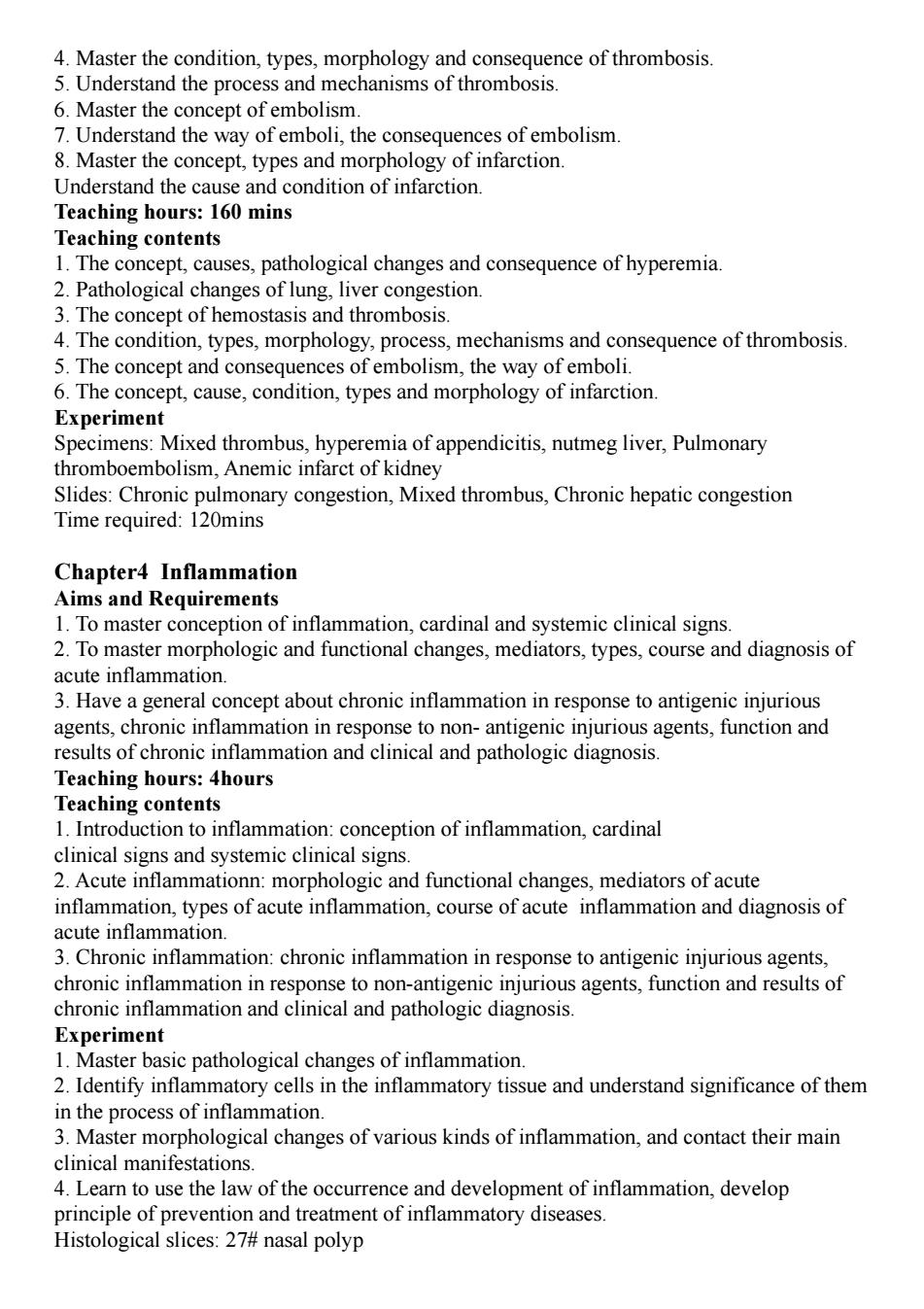正在加载图片...

4.Master the condition,types,morphology and consequence of thrombosis 5.Understand the process and mechanisms of thrombosis. 6.Master the concept of embolism. 7.Understand the way of emboli,the consequences of embolism. 8.Master the concept,types and morphology of infarction. Understand the cause and condition of infarction. Teaching hours:160 mins Teaching contents 1.The concept,causes,pathological changes and consequence of hyperemia. 2.Pathological changes of lung,liver congestion. 3.The concept of hemostasis and thrombosis. 4.The condition,types,morphology,process,mechanisms and consequence of thrombosis. 5.The concept and consequences of embolism,the way of emboli. 6.The concept,cause,condition,types and morphology of infarction. Experiment Specimens:Mixed thrombus,hyperemia of appendicitis,nutmeg liver,Pulmonary thromboembolism,Anemic infarct of kidney Slides:Chronic pulmonary congestion,Mixed thrombus,Chronic hepatic congestion Time required:120mins Chapter4 Inflammation Aims and Requirements 1.To master conception of inflammation,cardinal and systemic clinical signs. 2.To master morphologic and functional changes,mediators,types,course and diagnosis of acute inflammation. 3.Have a general concept about chronic inflammation in response to antigenic injurious agents,chronic inflammation in response to non-antigenic injurious agents,function and results of chronic inflammation and clinical and pathologic diagnosis. Teaching hours:4hours Teaching contents 1.Introduction to inflammation:conception of inflammation,cardinal clinical signs and systemic clinical signs. 2.Acute inflammationn:morphologic and functional changes,mediators of acute inflammation,types of acute inflammation,course of acute inflammation and diagnosis of acute inflammation. 3.Chronic inflammation:chronic inflammation in response to antigenic injurious agents, chronic inflammation in response to non-antigenic injurious agents,function and results of chronic inflammation and clinical and pathologic diagnosis. Experiment 1.Master basic pathological changes of inflammation. 2.Identify inflammatory cells in the inflammatory tissue and understand significance of them in the process of inflammation. 3.Master morphological changes of various kinds of inflammation,and contact their main clinical manifestations. 4.Learn to use the law of the occurrence and development of inflammation,develop principle of prevention and treatment of inflammatory diseases. Histological slices:27#nasal polyp4. Master the condition, types, morphology and consequence of thrombosis. 5. Understand the process and mechanisms of thrombosis. 6. Master the concept of embolism. 7. Understand the way of emboli, the consequences of embolism. 8. Master the concept, types and morphology of infarction. Understand the cause and condition of infarction. Teaching hours: 160 mins Teaching contents 1. The concept, causes, pathological changes and consequence of hyperemia. 2. Pathological changes of lung, liver congestion. 3. The concept of hemostasis and thrombosis. 4. The condition, types, morphology, process, mechanisms and consequence of thrombosis. 5. The concept and consequences of embolism, the way of emboli. 6. The concept, cause, condition, types and morphology of infarction. Experiment Specimens: Mixed thrombus, hyperemia of appendicitis, nutmeg liver, Pulmonary thromboembolism, Anemic infarct of kidney Slides: Chronic pulmonary congestion, Mixed thrombus, Chronic hepatic congestion Time required: 120mins Chapter4 Inflammation Aims and Requirements 1. To master conception of inflammation, cardinal and systemic clinical signs. 2. To master morphologic and functional changes, mediators, types, course and diagnosis of acute inflammation. 3. Have a general concept about chronic inflammation in response to antigenic injurious agents, chronic inflammation in response to non- antigenic injurious agents, function and results of chronic inflammation and clinical and pathologic diagnosis. Teaching hours: 4hours Teaching contents 1. Introduction to inflammation: conception of inflammation, cardinal clinical signs and systemic clinical signs. 2. Acute inflammationn: morphologic and functional changes, mediators of acute inflammation, types of acute inflammation, course of acute inflammation and diagnosis of acute inflammation. 3. Chronic inflammation: chronic inflammation in response to antigenic injurious agents, chronic inflammation in response to non-antigenic injurious agents, function and results of chronic inflammation and clinical and pathologic diagnosis. Experiment 1. Master basic pathological changes of inflammation. 2. Identify inflammatory cells in the inflammatory tissue and understand significance of them in the process of inflammation. 3. Master morphological changes of various kinds of inflammation, and contact their main clinical manifestations. 4. Learn to use the law of the occurrence and development of inflammation, develop principle of prevention and treatment of inflammatory diseases. Histological slices: 27# nasal polyp